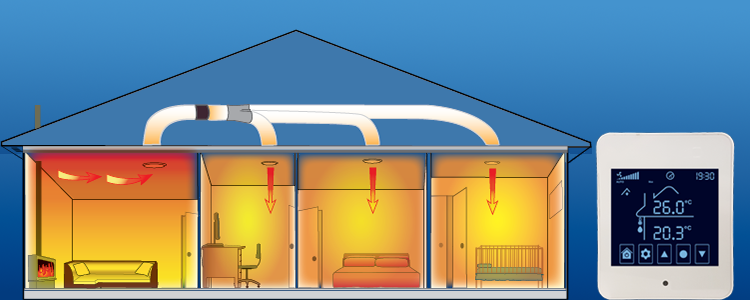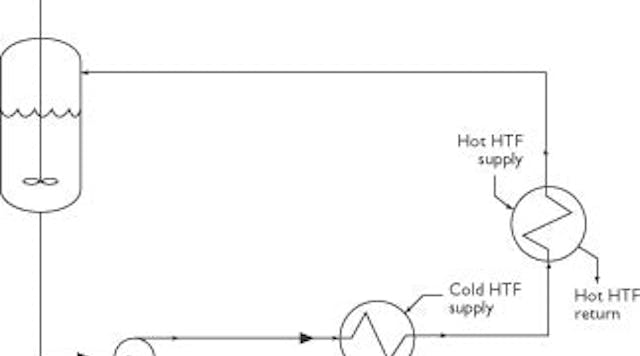Real-Time Monitoring: How DVS Heat Transfer Systems Enable Predictive Maintenance
Checking out the Perks and Applications of Heat Transfer Solutions in Modern Sector
Heat transfer systems play a necessary duty in contemporary market. They include various mechanisms such as conduction, radiation, and convection, each adding to effective thermal management. Industries like manufacturing and aerospace benefit greatly from these systems. As advancements proceed, the assimilation of innovative products and innovations promises to boost energy performance. This evolution increases crucial questions concerning the future effects for sustainability and functional expenses across numerous fields. What exists in advance in this ongoing transformation?
Recognizing Heat Transfer Concepts
Heat transfer principles are basic to the operation of numerous industrial systems. These concepts include the devices of convection, radiation, and transmission, each playing a crucial role in taking care of thermal energy. Recognizing conduction entails examining how Heat relocates with strong products, while convection refer to Heat transfer in fluids, driven by liquid motion. Radiation, unique from the various other two, involves power transfer through electromagnetic waves. The efficiency of Heat transfer influences system performance, power intake, and overall performance. Efficient thermal administration is important in procedures such as air conditioning, Heat, and heating recuperation. By grasping these concepts, industries can optimize their operations, decrease power prices, and boost equipment durability, consequently adding to a more lasting and efficient industrial landscape.
Key Kinds Of Heat Transfer Equipments
While different industries make use of Heat transfer systems for varied applications, numerous essential types stick out as a result of their particular functions and performances. The most usual types consist of transmission, convection, and radiation systems. Conduction systems transfer Heat through straight contact between products, making them effective in solid-state applications. Convection systems, on the other hand, utilize fluid movement to transfer Heat, ideal for heating or cooling down fluids and gases. Radiation systems operate without a tool, depending on electromagnetic waves to transfer Heat, suitable for high-temperature settings. Each kind offers unique purposes, permitting sectors to customize their Heat transfer options based upon functional requirements, energy efficiency, and cost-effectiveness. Understanding these systems is important for enhancing performance in different industrial settings.
Industrial Applications of Heat Transfer Technologies
The application of Heat transfer innovations in sector plays a necessary function in enhancing power efficiency and maximizing procedures. DVS Heat Transfer Systems. By applying innovative Heat exchange systems, business can greatly lower their environmental effect while improving general performance. This integration not only cultivates sustainability but additionally aligns with modern-day regulatory and consumer demands for greener methods
Energy Effectiveness Improvements
As industries significantly prioritize sustainability, power effectiveness improvements in Heat transfer technologies have actually become crucial for minimizing functional expenses and ecological influence. Improved Heat exchangers, for example, utilize sophisticated materials and layouts to take full advantage of thermal efficiency while decreasing energy usage. In addition, integrating variable speed drives in pumping systems permits far better control of liquid flow, resulting in substantial power cost savings. The application of clever sensors and automation offers real-time tracking, making it possible for adjustments that enhance energy usage. Furthermore, waste Heat recovery systems catch excess thermal power, transforming it right into useful power. These improvements not just boost energy effectiveness but additionally add to a much more sustainable industrial landscape by reducing greenhouse gas discharges and sustaining conformity with ecological policies.
Refine Optimization Techniques
Refine optimization methods are critical in enhancing the efficiency and effectiveness of Heat transfer technologies in industrial applications. These methods include refining procedures to maximize Heat transfer performance while reducing power consumption and functional expenses. Techniques such as computational fluid dynamics (CFD) modeling allow engineers to analyze and simulate Heat transfer situations, identifying locations for renovation. Furthermore, real-time tracking systems can offer important data on temperature level slopes and circulation rates, enabling adjustments that maximize performance. Furthermore, implementing innovative control methods, such as predictive analytics, can enhance system responsiveness to varying functional needs. By applying these optimization techniques, markets can achieve higher thermal efficiency, lowered downtime, and enhanced item high quality, ultimately leading to raised competitiveness in the marketplace.

Ecological Impact Decrease
While industrial Heat transfer modern technologies are necessary for operational performance, their application also offers opportunities for substantial environmental effect decrease. By enhancing energy effectiveness, these systems decrease fuel usage, leading to lower greenhouse gas exhausts. Advanced Heat exchangers can recoup waste Heat, redirecting it to preheat incoming liquids, thereby decreasing power needs. Additionally, the integration of Heat transfer innovations in renewable resource systems, such as solar thermal and geothermal applications, supports the change to lasting methods. Industries that use these modern technologies also gain from decreased operational expenses and boosted regulatory compliance. On the whole, the tactical application of Heat transfer systems not only boosts productivity however likewise promotes a more sustainable industrial landscape, contributing to global environmental goals.
Advantages of Reliable Heat Transfer Systems
Efficient Heat transfer systems offer significant advantages in modern sector, largely via boosted energy efficiency and price decrease. By maximizing thermal monitoring, these systems lessen energy waste, causing reduced functional prices (DVS Heat Transfer Systems). Services can achieve higher sustainability and boosted productivity.

Power Performance Improvements
As markets significantly focus on sustainability and cost-effectiveness, energy performance improvements in Heat transfer systems have actually become an essential emphasis. Boosted efficiency in these systems results in minimized power intake, read this making it possible for centers to run even more sustainably. By enhancing Heat transfer approaches, sectors can decrease waste Heat and attain far better click this thermal management, significantly reducing their environmental effect. Advancements in innovations such as Heat exchangers and insulation materials contribute to improved performance and reliability. Executing energy-efficient Heat transfer remedies not just supports conformity with regulatory criteria however also fosters a society of innovation within organizations. Eventually, these renovations are vital in straightening commercial procedures with international power preservation goals, paving the method for an extra sustainable future in manufacturing and handling sectors.
Price Reduction Opportunities
By optimizing Heat transfer systems, sectors can expose substantial expense reduction chances that enhance their profits. Effective Heat transfer lowers energy consumption, bring about lower energy expenses and minimizing functional expenses. Furthermore, enhanced system efficiency decreases the requirement for upkeep and repair work, in addition saving prices gradually. Boosted Heat transfer can also extend devices life-span, enabling business to postpone capital investment on substitutes. Waste Heat healing systems can change excess Heat into functional power, even more driving down expenses. These systems not just enhance processes but likewise add to sustainability initiatives, positioning business favorably in a significantly eco-conscious market. Generally, the economic benefits of efficient Heat transfer systems are considerable and important for competitive advantage.
Innovations in Heat Transfer Solutions
How can modern market improve its procedures with cutting-edge Heat transfer remedies? By embracing innovative products and technologies, industries can significantly enhance thermal effectiveness and efficiency. Advancements such as nanofluids, which enhance Heat transfer abilities past standard liquids, and stage adjustment products that save and launch thermal power, are obtaining grip. In addition, the assimilation of wise sensors and IoT gadgets allows for real-time monitoring and optimization of Heat transfer procedures, minimizing waste and boosting system responsiveness. In addition, additive manufacturing techniques allow the production of even more intricate Heat exchangers that make the most of surface location while lessening product usage. Jointly, these technologies drive operational efficiency and develop affordable advantages in numerous markets, including aerospace, manufacturing, and power.
The Role of Heat Transfer in Sustainability Initiatives
While the push for sustainability proceeds to improve markets, the function of Heat transfer modern technologies ends up being increasingly essential in achieving ecological goals. Reliable Heat transfer systems help with energy efficiency by optimizing thermal monitoring in various processes, substantially decreasing energy intake and greenhouse gas emissions. Progressed Heat exchangers are used in commercial applications to reclaim waste Heat, consequently try here minimizing energy waste. Furthermore, innovations such as phase adjustment materials boost thermal storage space, contributing to sustainable power integration. The fostering of lasting liquids in Heat transfer systems can reduce environmental effect. By focusing on reliable Heat transfer, markets not only improve functional efficiency yet also align with worldwide sustainability campaigns, cultivating a cleaner, extra sustainable future.
Frequently Asked Questions
Just How Do Heat Transfer Equipments Impact Energy Expenses in Manufacturing?
Heat transfer systems noticeably affect energy costs in production by improving efficiency, reducing waste, and maximizing thermal monitoring. These renovations result in reduce operational costs, eventually benefiting total performance and earnings in commercial procedures.
What Upkeep Is Required for Heat Transfer Systems?
Maintenance for Heat transfer systems consists of routine evaluations, cleaning of parts, examining liquid levels and conditions, changing used parts, and guaranteeing proper insulation. These activities improve efficiency, expand life-span, and avoid costly malfunctions in procedure.
Are There Safety And Security Interest In Heat Transfer Solutions?
Security issues with Heat transfer systems include potential leakages, pressure build-up, and thermal hazards. Proper layout, regular maintenance, and adherence to safety and security protocols are vital to minimize these threats and assure secure procedure in industrial atmospheres.
How Can I Select the Right Heat Transfer System for My Business?
Selecting the right Heat transfer system includes evaluating elements such as performance, application requirements, budget restrictions, and safety and security standards. A detailed evaluation of these components will help ensure ideal performance and dependability in organization procedures.
What Prevail Failures in Heat Transfer Solutions and Their Reasons?

Comprehending transmission involves assessing how Heat relocates through strong products, while convection pertains to Heat transfer in fluids, driven by liquid motion. By enhancing Heat transfer approaches, markets can reduce waste Heat and accomplish far better thermal administration, significantly decreasing their environmental effect. Waste Heat healing systems can change excess Heat into functional power, additionally driving down costs. Progressed Heat exchangers are utilized in commercial applications to recover waste Heat, therefore lessening energy waste. Typical failings in Heat transfer systems consist of leakages, corrosion, and ineffective Heat exchange.